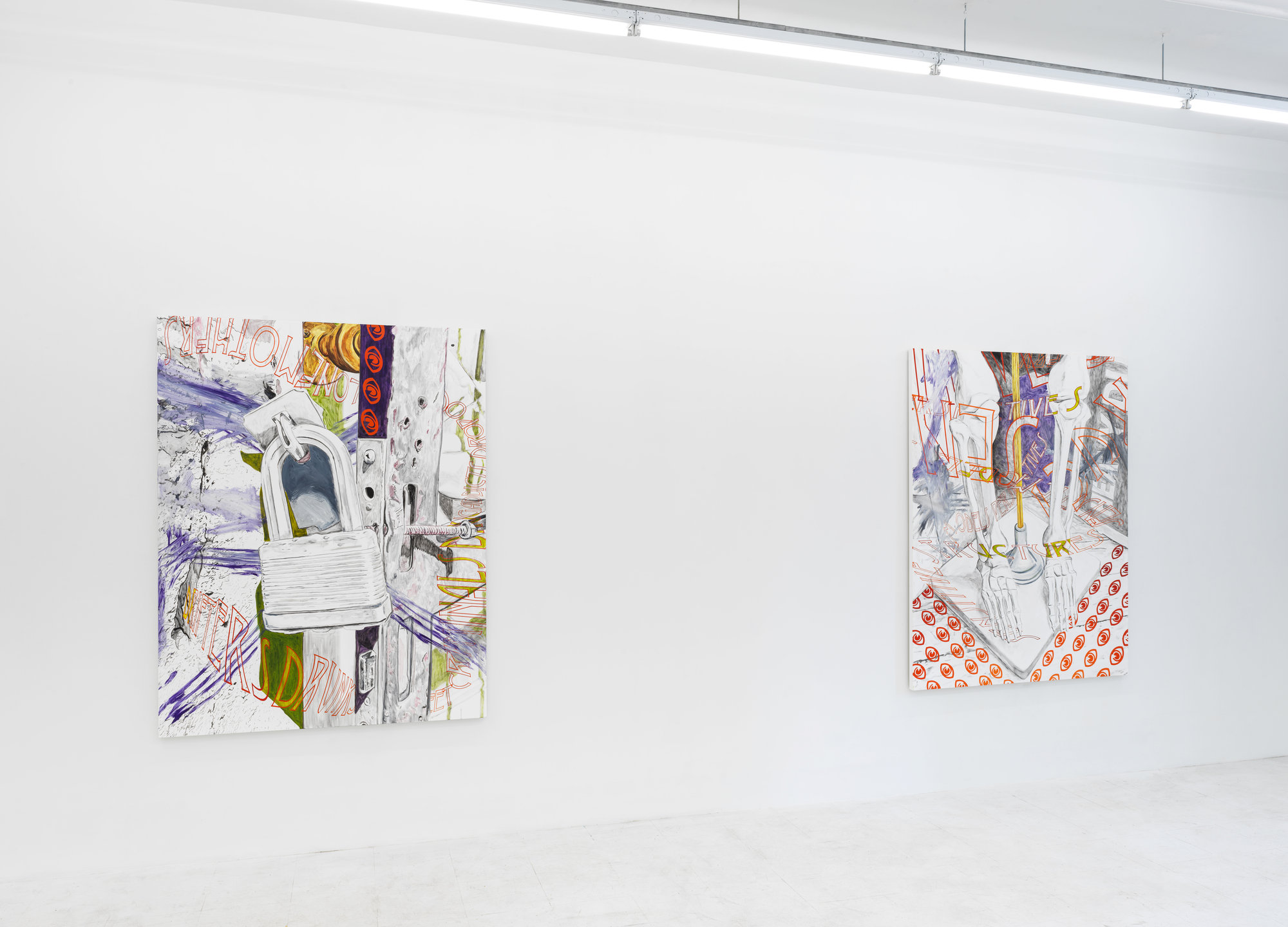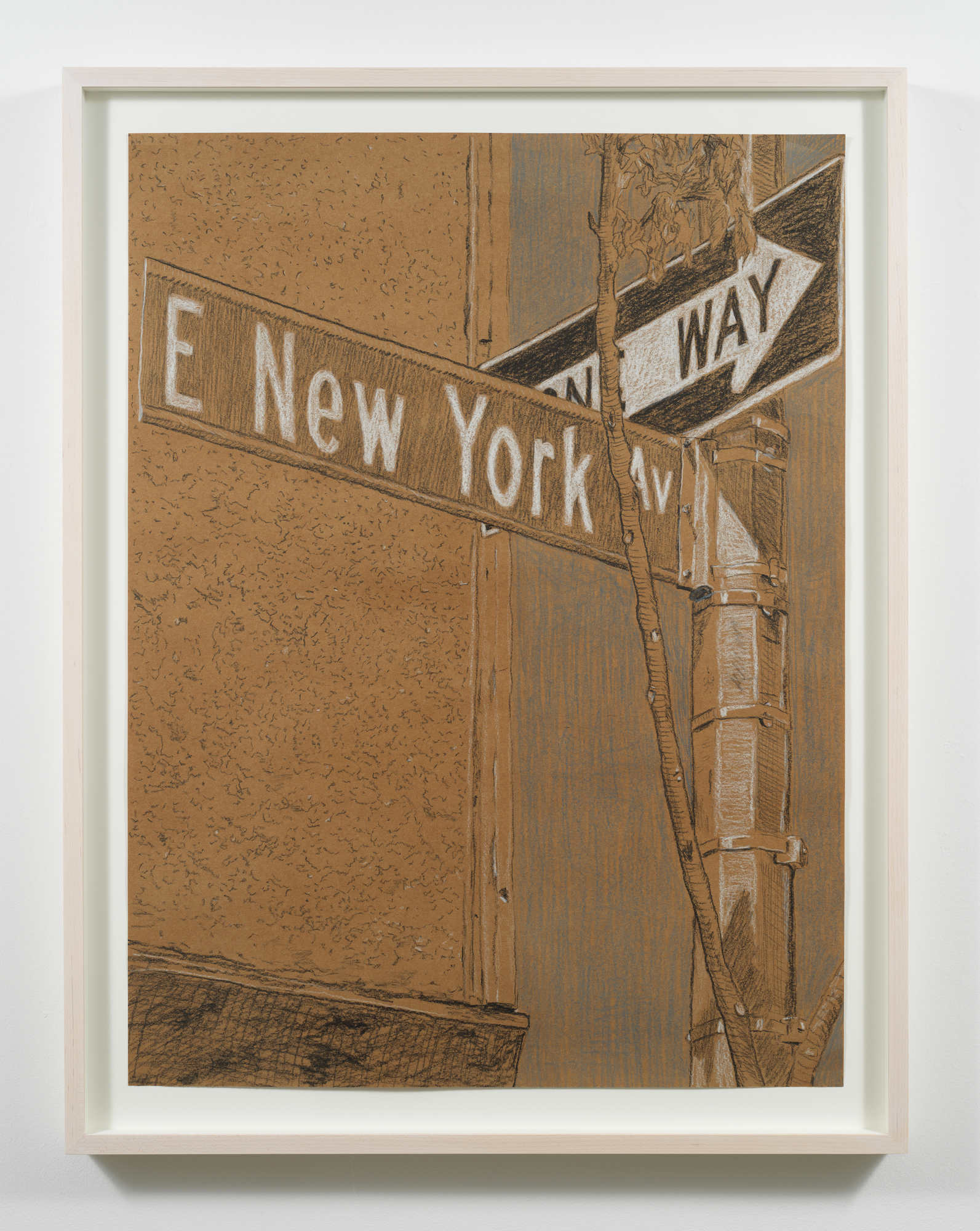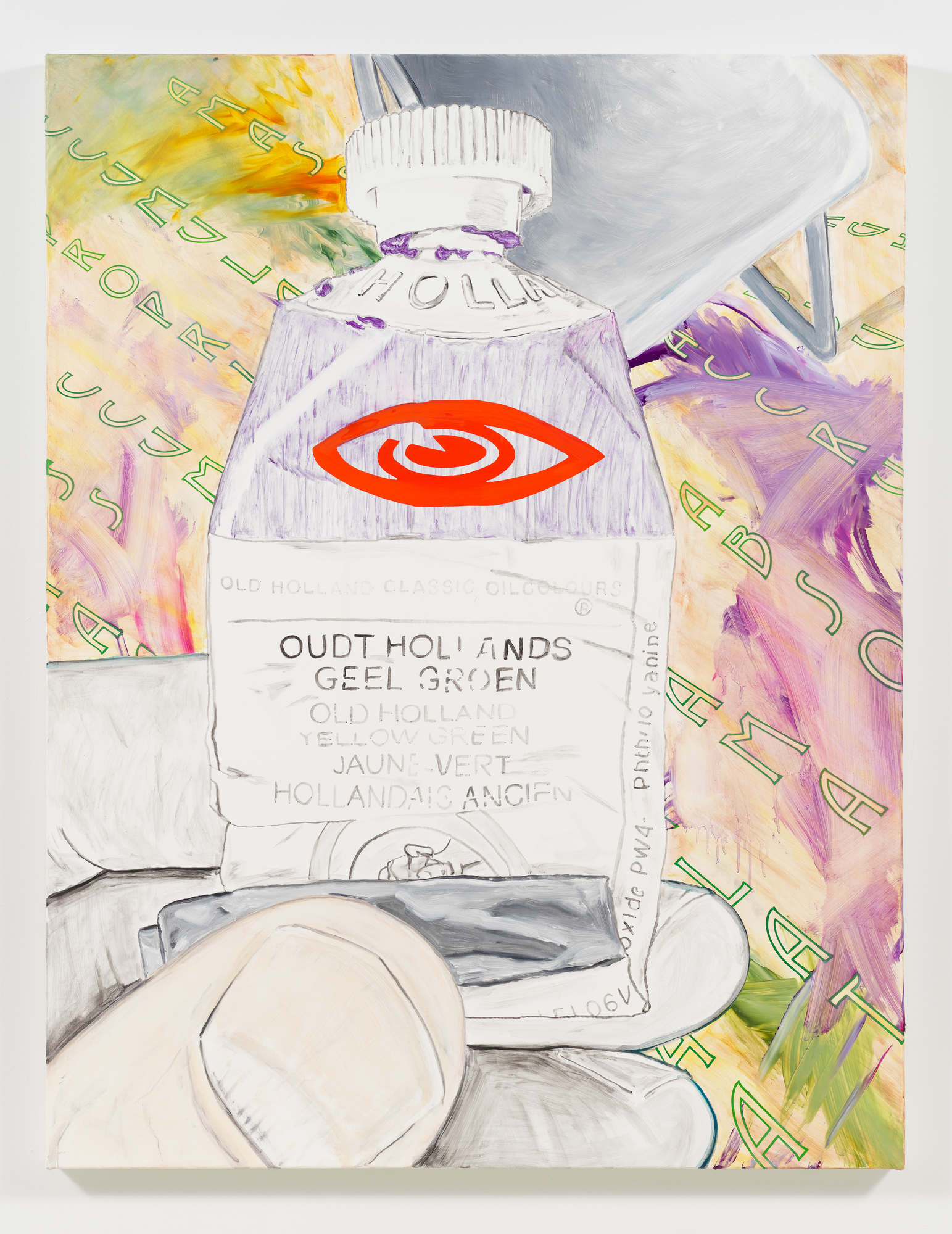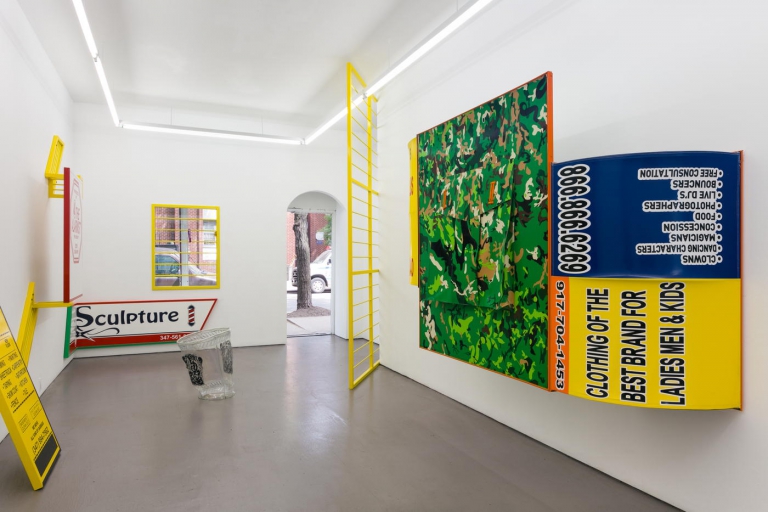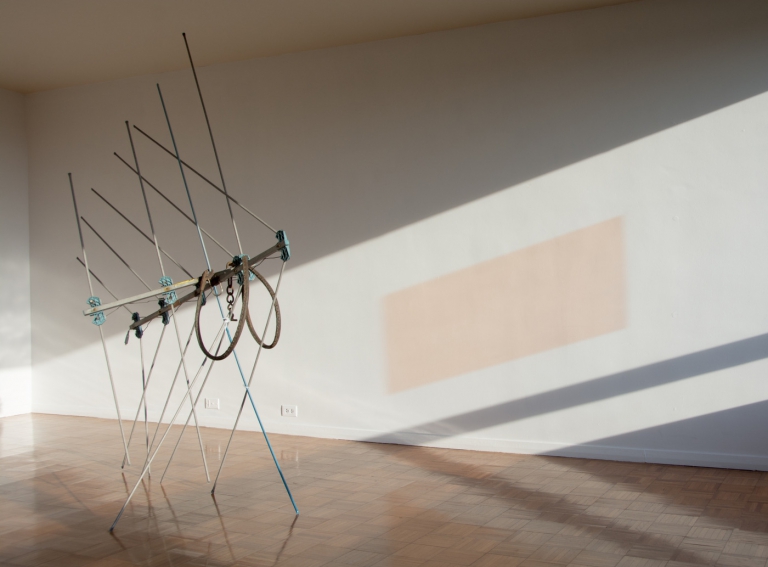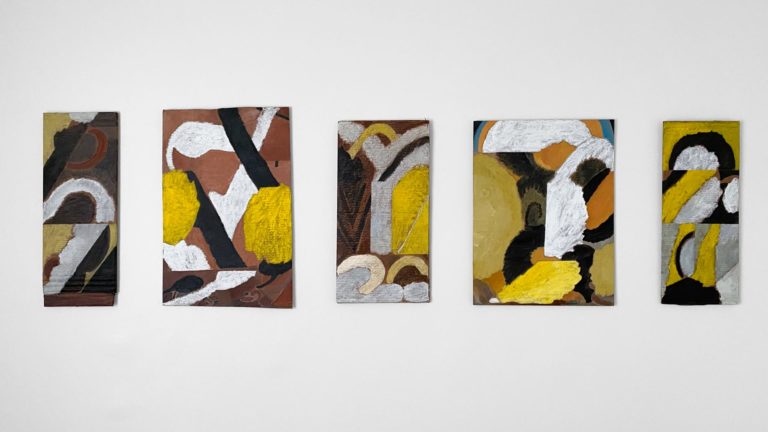Artist: Matteo Callegari
Exhibition title: Dropouts and Fluids
Venue: Tara Downs, New York, US
Date: June 20 – August 3, 2018
Photography: all images copyright and courtesy of the artist and Tara Downs, New York
APPROPRIATE, AMASS, ACCRUE. These directives among others sweep in downward-canted textual runnels interpolated across Matteo Callegari’s oil-on-canvas painting amass (all works 2018). Unmoored signifiers in this hard-cropped, self-reflexive rendering of the constitutive material basis of painting itself – a half-sealed tube branded as Old Holland’s singularly bilious yellow green palmed in the painter’s hand – invoke an anxious shuttling between the unspooling, quasi-synchronous axes of Callegari’s elected disciplinary matrix: painting-as-medium and painting as code to the transverse consumptions and disbursements of cultural artifactuality. The tube, meanwhile, is dubiously labeled.
Daubed with a viscid, grape-tinted discharge, it calls into question the veracity of all nodes in the network: one implicitly involving not simply this work but also three additional paintings in which the hue features prominently at once as scumbling highlight and constellated cipher. It is as if the actuality of paint is inseparable from its descriptive insufficiency and baiting of misapprehension. Together, these four paintings and a single charcoal and pencil drawing comprise Dropouts and Fluids at Downs & Ross, the first solo exhibition by the artist engaged in total with figurative portrayal. The works, encompassing textual elements and pictorial content external to the canvas, direct attention towards newly added thresholds of information – marking a far-reaching departure from the well-known body of abstract composition he has developed for nearly a decade.
DRIFTERSDRUNKS, LONEMOTHERS, STREETCRIMINALS. In guilloche-like wandering ribbons, these disappropriative compounds circumscribe a padlock figured at the center of dropouts. On the one hand, their definition at the painting’s perimeter amplifies the marginalization and ontological deprivation coincident with these terms; on the other, it situates the painting’s reflexive awareness of a systematically expropriative infrastructure typified by the eastern Brooklyn streetscape that includes the artist’s studio. Where, previously, Callegari’s abstract paintings diagrammed digitally-mediated Renaissance vernaculars digested dually by irregular painterly maculations and rule-based curvilinear networks – registering their own internalized address of the compression of historical ideational vectors into optically-assertive surface conditions – these newest works shift emphasis to the in-plain-sight conditions of the artist’s studio and obtrusive realities of direct experience. If DRUGADDICTS, queasily lettered across dropouts, corresponds to the shackle lock of an abject semiotic foreclosure, Callegari’s painting further discloses a loosened hinge as well as a doorway – as embedded in its non-appraisal of outside and inside – agape to more fluid representational arrangements.
This is not to say that the artist asserts non-participation in these schema, as if staking surrogacy only in the eyes disincarnate whose logo -like glyphs litter his canvases in pasteup-like profusions. Wending into and out of the frame of his close -cropped compositions – like the free-floating, neo -gothic type that iterates a long-standing modus of lexical integrations indefinitely traceable to Martin Kippenberger’s belligerently paralogical disjunctions, the swaggering club-kid poetics of Bernadette Corporation, ravenous theoretical inherences of Jutta Koether, and the dagger-edged over -oblique Futura variants spilling from picked-over HBA sample sales running through them – Callegari’s presence is in fact wincingly overwhelming, borne of self- assertive depiction of his own hand and the pervasive, only apparently brushless smears of ‘yellow-green’ whose four-fingered contours role-play a dermal-level interlocution between artist and artwork. Specific evidence of the artist’s diaristic investment in these views thus feints over-intimacy even while paralleling the wavering planarity on which their words hang in ambiguous suspension as if seen in the casual passing of a storefront vitrine or Dan Graham double-mirror – a reflective analogy that elicits a clinical comprehension of his artwork’s concomitant predication and predation on the effects of marketability. In a cautionary imaginary – apprehensive as the graphic novel vignettes it evokes – we are forewarned that the imperative to ABSOLVE sidles comfortably under a medium marked the impure color of envy.
Matteo Callegari (b. 1979, Latisana, IT; lives and works in New York) received a Bachelor in Economics from Università Ca’ Foscari, Venice, and an MFA from Hunter College, New York. Solo exhibitions: Downs & Ross, New York; And Now, Dallas; Federico Vavassori, Milan; Carl Kostyál, London; Ramiken Crucible, New York; 39 Great Jones, New York. Selected group exhibitions: 83 Pitt Street, New York; Instituto Italiano di Cultura, New York; Molecules in Motion, Oslo; Sommer Contemporary Art, Tel Aviv; David Lewis Gallery, New York; Galleria Francesca Minini, Milan; Lucie Fontaine, Milan; Palais de Tokyo, Paris; Galerie Eva Presenhuber, Zurich; Ramiken Crucible, New York; and The Artist’s Institute, New York.
Matteo Callegari, dropouts, 2018, Oil on canvas, 66 × 51 inches / 168 × 130 cm
Matteo Callegari, structures, models, perspectives, 2018, Oil on canvas, 66 × 51 inches / 168 × 130 cm
Exhibition view, Matteo Callegari: Dropouts and Fluids, 2018, Downs & Ross, New York
Matteo Callegari, ENY, 2018, Charcoal and pencil on paper, 24 × 18 inches / 60.96 × 45.72 cm
Exhibition view, Matteo Callegari: Dropouts and Fluids, 2018, Downs & Ross, New York
Exhibition view, Matteo Callegari: Dropouts and Fluids, 2018, Downs & Ross, New York
Matteo Callegari, amass, 2018, Oil on canvas, 44 × 34 inches / 112 × 86 cm
Matteo Callegari, fluids, 2018, Oil on canvas, 44 × 34 inches / 112 × 86 cm
Exhibition view, Matteo Callegari: Dropouts and Fluids, 2018, Downs & Ross, New York



